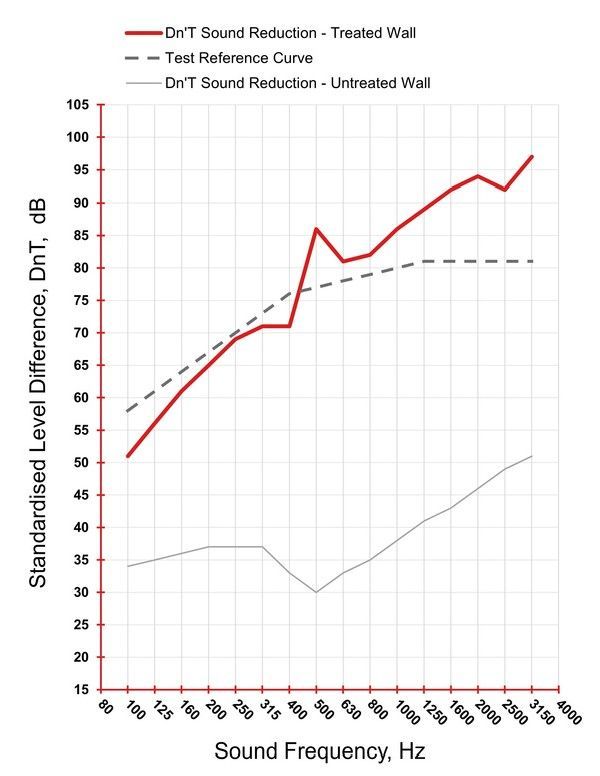Understanding Decibels and Sound Test Figures
The first thing to explain is that the Decibel System and sound testing is a very complex subject requiring years of training to properly understand. The following information is intended to explain the most relevant points that you need in the context of choosing the best soundproofing system for your needs, while attempting to simplify this very complex subject. Simplifying does mean that we lose some of the finer detail and nuance but will hopefully make it more digestible for people looking at decibel and sound test figures for the first time.
What are Decibels?
The most important thing to understand is that Decibels are NOT a fixed unit of measurement. A fixed unit of measurement is something like a centimetre or kilogram for example. Regardless of whether you are looking at 1 centimetre from 1 to 2 or 10 to 11 or 100 to 101, the size of the centimetre is always exactly the same. Decibels do not work like this.
Decibels describe the relationship between two units of power and the units of power that they are in relation to, can cover a huge range. For example, comparing 1 to 1 trillion. For this reason, Decibels are displayed Logarithmically, which basically means that Decibels get exponentially bigger as they go up the scale. So, 1 Decibel from 90 to 91dB is many, many, many times greater than the 1 Decibel from 10 to 11dB.

Because of this Logarithmic scale and the average sensitivity of human hearing, we generally perceive every 10dB increase as a doubling of volume, or in reverse every 10dB reduced as a halving of volume.
For example, if you were listening to your TV and the TV was set to volume 60, reducing 10dB of volume would be like turning the TV down from 60 to 30 (not 50 as people assume), halving the volume. Reducing a further 10dB would turn the volume down from 30 to 15, a further 10dB reduction would turn the volume from 15 to 7.5 and so on halving every time. The size of the reduction gets smaller as the volume gets lower because the Decibels at that lower volume are much smaller.
How Are Sound Tests Carried Out?
All the soundproofing systems at The Soundproofing Store (and most other soundproofing companies) will have an advertised sound reduction figure. It is important to understand what this means. These figures are gathered from performing a sound reduction test.
It is important to understand first of all that sound reduction tests are generally not performed on the product or system in isolation, it is performed installed in a situation similar to how it is intended to be used.
This is because the sound reduction you get from the product changes depending on the conditions it is being used. For example if you test a single layer of acoustic plasterboard on its own it will reduce 29dB, If you install the same layer of acoustic plasterboard onto a brick wall that is already reducing 44dB the addition of the plasterboard will not give you even one single extra decibel of reduction because the brick wall has already done what the plasterboard is intended to do but better than the plasterboard does it. You get zero improvement. You don’t add the 29dB of the plasterboard on its own to the 44dB of the wall and get 73dB, it just doesn’t work like that. So, if you are trying to improve the sound reduction of your brick wall, it is completely pointless for you to know what the product does on its own; you want to know how it performs once installed on your wall.
For this reason, it is important to know the full construction details of the test. Here at The Soundproofing Store, we give the details of the full construction that was tested, the performance of the construction before the soundproofing was added and the improvement gained from the soundproofing.
To gather that dB figure the system or product is installed onto its intended construction either in a certified acoustics laboratory or “in situ” on a real life site. On one side of the construction (let’s say a wall for this example), a speaker system is set up which plays a “white noise” covering a wide range of sound frequencies from low bass to high treble at around 100dB volume (extremely loud). The tester then goes to the room or property on the other side of the wall and measures the volume in that room (receiving room). The difference between the 100dB source and the volume in the receiving room is the sound reduction. Say for example the volume in the receiving room was 40dB then the sound reduction figure that would be advertised is 60dB as the wall with the soundproofing has reduced 60dB of volume from one side to the other.
One thing to bear in mind is that this single figure is an average of the performance across the range of frequencies, it doesn’t mean that all the frequencies are reduced by the same amount. Using the example of the 60dB reduction, the wall may have been reducing higher frequencies much more such as 80dB or 90dB but reducing the lower bass frequencies by only 20dB, but averaging across the range gives us the 60dB. It is good to understand this as some systems may advertise a high reduction figure as an average but perform very poorly at the frequency of your particular noise problem. So, the average figure is helpful as a rough guide, but further research is needed on the full performance of the system across the frequency range to ensure the best results for you.

Will you get the exact same result as advertised?
In short, probably not. Again, the result is partly due to the soundproofing and partly due to the construction. If your construction is different, the result will be different. If your wall is already performing better than the wall in the test you may achieve a better result, if your wall is worse than the tested wall you may get a lower result.
Also, that reduction was based on reducing white noise which started at 100dB. Your noise problem is unlikely to be white noise and unlikely to be exactly 100dB. The conditions are different therefore the result will be different. Again, the test figures should be used as a guide to compare systems tested in the same way on the same type of construction, not as an indication of exactly what you will achieve in your unique situation.
Comparing Soundproofing Systems
For all the reasons above you can see why it is very difficult to compare the performance figures of different systems unless they have been tested on the same or very similar construction. At The Soundproofing Store we have tested all of our systems on the same or very similar constructions so that the figures are comparable. However, if you are looking at the figures from a different company or manufacturer, the decibel figures aren’t necessarily comparable. For example, we may advertise the performance of a wall system at 60db, another company could advertise a system at 65dB, so you would initially assume that system is better, however if our system was tested on a wall that was previously reducing 40dB, then the soundproofing system has improved the wall by 20dB. The competitor system may have been tested on a much thicker wall that was already reducing 50dB, so their system has only given a 15dB improvement. The only way to know how they compare is to test them on the same construction.
Different Decibel Types
The final thing to understand is that not all Decibel figures are the same. Once a test has been carried out and the reduction figures across the frequency range have been gathered there are different calculations that can be used to average that performance into the final figure. A good example is how you can average a group of numbers by a mean, mode or median average which will change the final figure. With Sound testing the most common types in the UK are DnT,w, DnT,w+Ctr, Rw, Rw+Ctr.
Explained very simply;
DnT,w is the standard averaged sound reduction, DnTw+Ctr is the same figure but with the addition of a low frequency performance correction. In other words, a system may achieve a good average because it performs very, very well at high frequencies but poorly at low frequencies. The DnT,w+Ctr will make a correction for the poor performance at low frequencies and reduce the average. So, two systems could be advertised with the same DnT,w but have a different DnT,w+Ctr because one performs worse at low frequencies.
Rw and Rw+Ctr are the same as above but the test has been carried out in a certified acoustics laboratory, DnT,w has been tested on a real site. Laboratory tests tend to have slightly higher figures due to the “perfect” conditions of the lab. Site tests are likely to have imperfections and flanking transmission paths that result in a lower but more realistic result.
Again, when comparing systems especially with different manufacturers, you need to know that you are looking at comparable figures, comparing the DnT,w of one system against the DnT,w+Ctr of another system or the DnT,w of one against the Rw of another is an unfair comparison and will lead to misguided decisions.
Conclusion
It is important to give people some sort of data to try and base their decision on. However it is important to understand that these figures are a guide to compare systems that have been tested in the same way and on the same construction type to see which systems do the best job. However this can lead to ill informed decision making if you try and compare systems that have been tested in different ways, on different construction types or using different Decibel calculations. Don’t just look at the main figure but also the full frequency performance graph to see how the systems perform at various frequencies.
Congratulations if you have made it to the end of this, we hope you now feel more informed to research and make good decisions. Remember soundproofing and sound in general is very complex, we don’t expect you to become an expert overnight. If you need help get in touch with our friendly but highly knowledgeable team of technical advisors who can help point you in the correct direction for your situation.
We’re here to help.
Airborne Test Figures
-
RwList Item 1
Rw is the weighted sound reduction index in dB (decibels) and it describes the airborne sound insulating power of a building element. It is a laboratory measured value as defined in ISO 717-1. It can apply to walls, ceilings, floors, roofs, doors or windows. The higher the number, the greater the sound insulating power of the element.
An increase in the Rw of a wall by 6 points will reduce the perceived loudness of sound passing through the wall by about half.
*used in building regulations for internal walls and floors
-
Rw + CtrList Item 2
Rw+Ctr is the Rw figure with the addition of a low frequency sound correction factor Ctr (a negative number). The use of Rw+Ctr has become more relevant due to the increase in low frequency sound sources such as surround sound systems, traffic and aircraft noise, drums and bass guitars and home entertainment equipment. Two walls can have the same Rw rating, but have different resistance to low frequency sound, thus a different Rw+Ctr
-
DnTwList Item 3
DnT,w is the equivalent of Rw, but measured on-site instead of in a laboratory setting.
*used in Scottish building regulations for walls and floors separating dwellings
-
DnTw +CtrList Item 4
DnT,w+Ctr is the equivalent of Rw+Ctr, but measured on-site instead of in a laboratory setting. This is the DnT,w figure with the addition of a low frequency sound correction factor.
*used in building regulations in England, Wales and N.Ireland for walls and floors separating dwellings
Impact Test Figures
-
Ln,wList Item 1
Ln,w describes how easily impact sound travels through a floor assembly. Ln,w is a laboratory measured value as defined in ISO 717-2.
Unlike airborne figures such as Rw, better performing floors have lower values not higher values.
-
LnT,wList Item 2
LnT,w is the equivalent of Ln,w but measured on-site instead of in a laboratory
*used in building regulations across the UK for floors separating dwellings
Why Soundproofing dB figures are only a guide?
We don’t expect you to become an overnight soundproofing expert, that’s what we’re here for.










